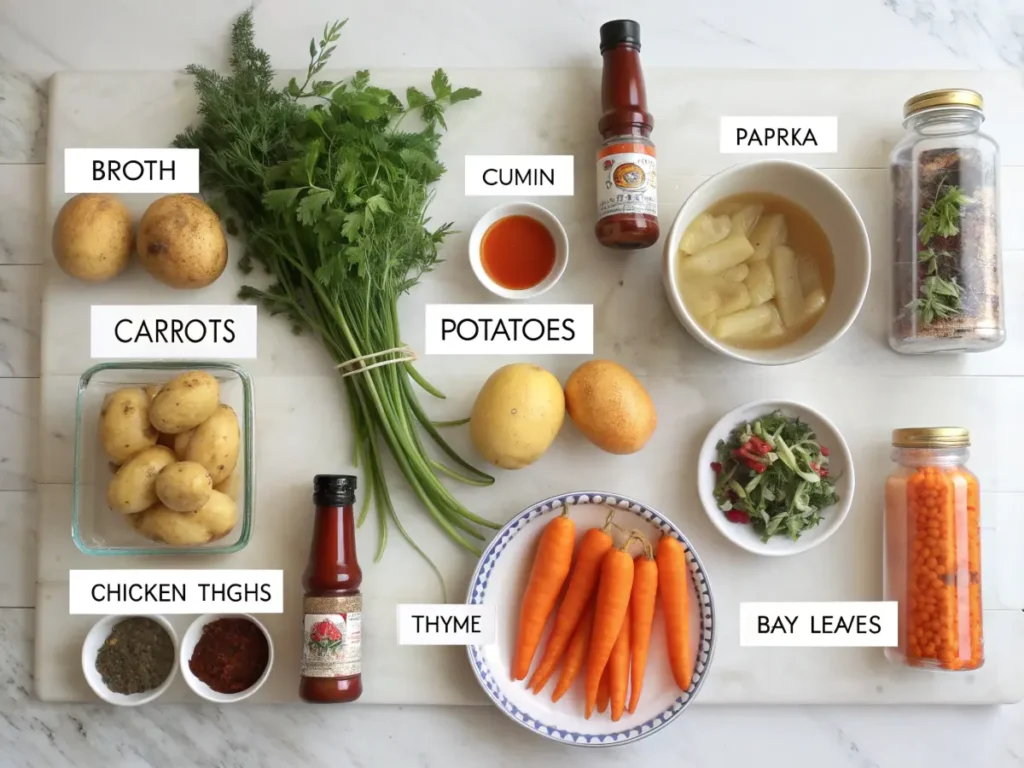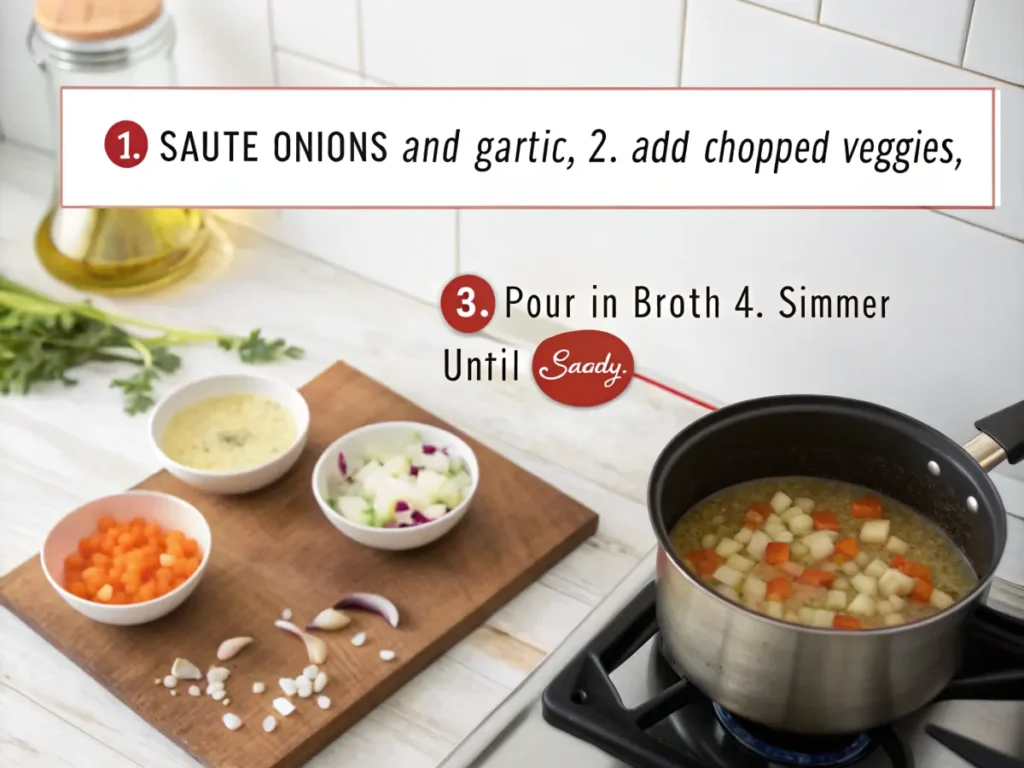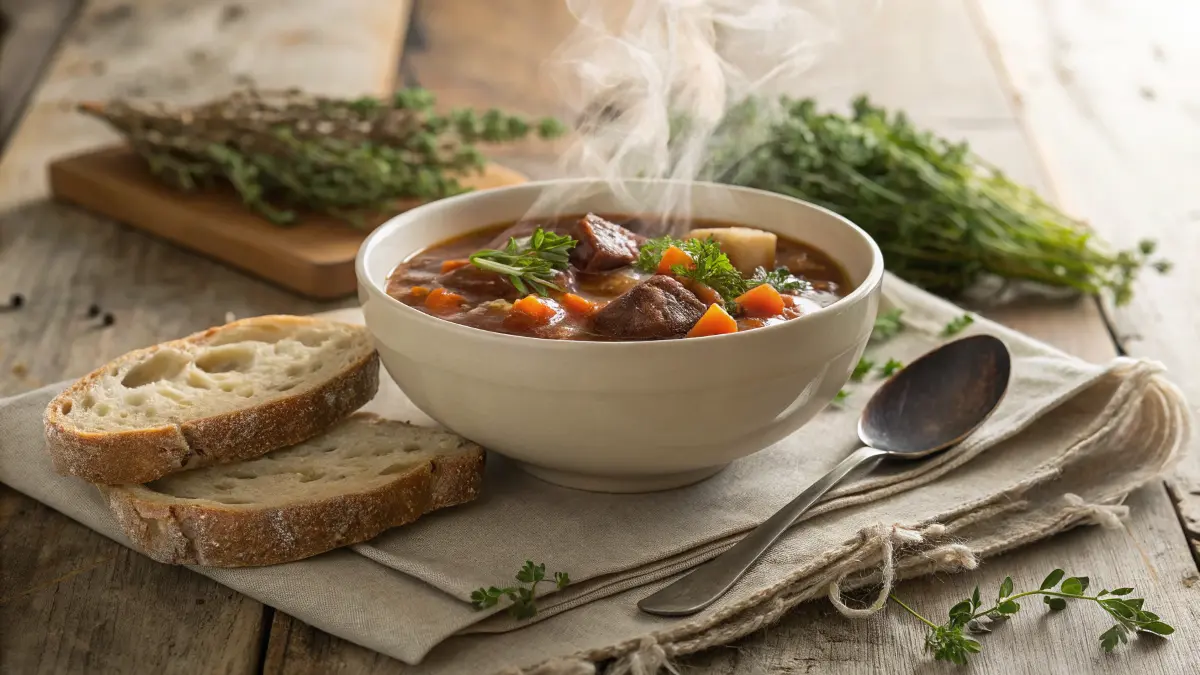There’s something about the smell of onions sizzling in a pot that instantly takes me back to my childhood. I can still picture my mom standing over the stove on a snowy afternoon, stirring a big pot of her famous chicken noodle soup. The steam would fill the kitchen, carrying with it the promise of warmth and comfort. Even now, as an adult with my own tiny apartment and mismatched cookware, I find myself drawn to the same ritual. Whether it’s a quick weeknight veggie stew or a lazy Sunday spent simmering beef bourguignon, there’s just nothing like the comfort of soups and stews to make everything feel a little cozier. So grab a seat—and maybe a napkin—because we’re diving deep into why these meals are pure magic.
Part 1: Why Soups and Stews Are the Ultimate Comfort Food
The Science Behind Comfort Foods
You know how sometimes a bowl of chicken noodle soup feels like a hug from the inside? Well, there’s actually science backing that up. Studies show that certain foods trigger serotonin production—the “happy hormone”—which helps us relax. And guess what? Many of those foods are staples in soups and stews, like carbs from potatoes or pasta, proteins from meat, and even veggies loaded with vitamins. It’s no wonder the comfort of soups and stews has been cherished for centuries.
How Soups and Stews Warm the Soul
Let’s face it—there’s something magical about sitting down to a piping hot bowl of stew on a chilly evening. Maybe it reminds you of grandma’s kitchen or lazy Sunday afternoons spent indoors. Whatever the case, soups and stews bring people together. Plus, they’re super versatile—you can toss in whatever you’ve got lying around, and boom, dinner’s ready!
Part 2: A Brief History of Soups and Stews
From Ancient Times to Modern Kitchens
Believe it or not, soups and stews have been around for thousands of years—like, way before your grandma’s secret recipe was even a thing. Archaeologists say that humans were making broth as far back as 20,000 BCE. Imagine this: early hunters tossing scraps of meat and wild veggies into a pot over an open fire. Sounds pretty rustic, huh? But honestly, that’s where it all began. Over time, different cultures added their own twists, turning simple broths into hearty meals we now call stews.
Fast forward to today, and you’ll find versions of these dishes in almost every corner of the globe. For instance, French onion soup, Moroccan tagine, Japanese miso soup—they’re all rooted in the same idea: using liquid to extract flavor and create something nourishing. It’s kinda cool how one concept can evolve so much, don’t you think?
How Cultures Around the World Celebrate the Comfort of Soups and Stews
Now let’s talk about how the comfort of soups and stews shows up worldwide. In Ireland, they’ve got Guinness beef stew—a rich, dark dish perfect for cold nights. Head over to Asia, and you’ll find pho, a fragrant noodle soup packed with herbs and spices. Meanwhile, down in Louisiana, gumbo reigns supreme, blending African, French, and Native American influences into a single bowl.
What makes these dishes special isn’t just their taste—it’s the stories behind them. Each culture brings its own flair, but at the heart of it, they’re all about bringing people together. Whether it’s a family feast or a solo supper, there’s no denying the universal appeal of a good bowl of soup or stew.
So next time you dig into a steaming bowl, take a moment to appreciate its long journey through history—it’s older than you might realize!
Part 3: Types of Soups and Stews to Try This Season

Classic Recipes That Never Go Out of Style
When it comes to the comfort of soups and stews , some recipes are simply timeless. Take chicken noodle soup, for example. This classic is like a warm blanket in a bowl, especially when you’re feeling under the weather. Then there’s chili con carne, a spicy favorite that’s perfect for game nights or cozy weekends. And who could forget beef bourguignon? With tender chunks of meat slow-cooked in red wine, it’s fancy enough for date night but comforting enough for a lazy Sunday.
If you’re looking for vegetarian options, lentil soup is always a winner. Packed with protein and fiber, it’s filling yet light—a total win-win. Oh, and don’t sleep on tomato basil soup either. Paired with grilled cheese? Absolute perfection.
Trending Twists on Traditional Favorites
But hey, classics aren’t the only game in town. Lately, chefs and home cooks alike have been putting creative spins on old favorites. Think ramen bowls topped with soft-boiled eggs and crispy tofu, or creamy pumpkin curry stew served with coconut rice. These modern takes keep things exciting while still delivering that familiar warmth we crave.
For those trying to eat healthier, bone broth soups are having a major moment. Not only are they low-calorie, but they’re also loaded with collagen, which is great for skin and joints. Another trend? Spices! Adding turmeric, ginger, or cayenne pepper gives your soups and stews an extra kick—and boosts their health benefits too.
Honestly, the possibilities are endless. Whether you stick to tradition or try something new, there’s no wrong way to enjoy the comfort of soups and stews . So grab your ladle and get cooking—you won’t regret it!
Part 4: Tips for Making Perfect Soups and Stews at Home

Stocking Your Pantry with Essentials
Let’s face it—making a killer soup or stew starts with having the right ingredients on hand. You don’t need anything fancy, just some pantry staples that can transform any dish. Think canned tomatoes, dried herbs like thyme and bay leaves, and of course, good-quality broth. Oh, and don’t forget spices! A pinch of cumin or smoked paprika can take your comfort of soups and stews to the next level.
If you’re feeling ambitious, try making your own stock. It’s easier than you think—just toss veggie scraps, bones, or leftover chicken into a pot, simmer for a few hours, and voila! Homemade goodness in a jar. Plus, it freezes beautifully, so you’ll always have some ready to go.
Quick Tricks for Faster Prep
Now, I know what you’re thinking: “Aren’t soups and stews supposed to cook all day?” Sure, slow-cooking is great, but who has time for that every night? Here’s the deal—you can still get amazing flavor without spending hours in the kitchen.
One trick is to use pre-cut veggies from the grocery store. Yeah, yeah, fresh is best, but sometimes convenience wins. Another tip? Sear your meat first. This locks in juices and adds depth to your dish. And if you’re short on time, grab an Instant Pot or slow cooker—they’re lifesavers when it comes to whipping up hearty meals fast.
Oh, and here’s a pro move: layer flavors. Start by sautéing onions and garlic, then add spices before pouring in liquids. This builds complexity without much effort. Honestly, once you master these basics, you’ll be whipping up the comfort of soups and stews like a pro in no time.
Part 5: Health Benefits of the Comfort of Soups and Stews
Nutrient-Packed Ingredients to Boost Your Immunity
Did you know that soups and stews aren’t just comforting—they’re also super healthy? Yep, they’re basically a one-pot wonder for packing in nutrients. For starters, most recipes include tons of veggies, which are loaded with vitamins and antioxidants. Carrots bring vitamin A, spinach adds iron, and sweet potatoes? They’re packed with fiber and potassium.
And let’s not forget about protein sources like beans, lentils, or lean meats. These keep you full longer while supporting muscle repair and energy levels. Plus, many broths (especially bone broth) contain collagen, which is great for skin, hair, and joint health. Talk about a win-win!
Why Broth-Based Meals Are Good for You
Here’s the thing: broth-based dishes are easy to digest, making them ideal for days when you’re feeling under the weather—or just want something light yet satisfying. The liquid helps hydrate your body, while the warmth soothes sore throats and calms nerves.
Another bonus? Portion control is built-in. Since soups and stews are filling, you’re less likely to overeat. And because they often include a mix of carbs, protein, and fats, they provide balanced nutrition in every bite.
So whether you’re fighting off a cold or simply craving the comfort of soups and stews , rest assured you’re doing your body a favor. Who knew eating well could taste this good?
Part 6: Pairing Soups and Stews with Sides and Drinks
Bread, Salads, and More: What Goes Best?
Let’s be real—no bowl of soup or stew is complete without something to dunk, scoop, or munch on the side. And when it comes to pairing, bread is king. A slice of crusty sourdough or warm garlic bread practically begs to soak up every last drop of broth. If you’re feeling fancy, whip up some cheesy biscuits or cornbread for a Southern twist.
But hey, if carbs aren’t your thing (or you’re trying to balance things out), a fresh salad works wonders too. Think crisp greens tossed with lemon vinaigrette or a tangy coleslaw. The contrast between the warm, hearty comfort of soups and stews and cool, refreshing sides is pure magic.
For heartier meals, roasted veggies or mashed potatoes are always crowd-pleasers. Honestly, there’s no wrong answer here—it’s all about what makes you happy.
Warming Beverages to Complement Your Meal
Now, let’s talk drinks. While water is always a safe bet, why not lean into the cozy vibes with something warm? Hot tea, like chamomile or peppermint, pairs beautifully with lighter soups. For richer stews, try a glass of red wine or even a spiced cider.
And don’t forget coffee lovers—sometimes a creamy latte hits the spot alongside a bowl of chili or lentil soup. Whatever you choose, just make sure it complements the flavors in your dish. After all, the goal is to create a meal that feels like a big ol’ hug.
Part 7: Creative Ways to Repurpose Leftover Soups and Stews
Transforming Leftovers into New Dishes
We’ve all been there—you made a huge pot of stew, and now you’re staring at leftovers wondering what to do. Fear not! The comfort of soups and stews doesn’t have to end after one meal. Get creative and turn those extras into something new.
For example, leftover chili can become a topping for baked potatoes or nachos. Or blend up yesterday’s veggie soup to use as a sauce for pasta. You could even pour leftover beef stew over mashed potatoes for a shepherd’s pie-inspired dish. See? Leftovers = opportunities.
Freezing Tips for Future Comfort
If you’re not ready to reinvent the wheel, freezing is your best friend. Portion out leftovers into airtight containers or freezer bags, label them with the date, and pop them in the freezer. They’ll stay good for up to three months, giving you instant comfort food whenever you need it.
Pro tip: freeze in smaller portions so you can thaw just what you need without wasting food. When reheating, add a splash of broth or water to refresh the texture. Boom—your future self will thank you.
Part 8: FAQs About the Comfort of Soups and Stews
People Also Ask Section Insights
Got questions about soups and stews? Don’t worry—we’ve got answers! Here are some common queries folks are searching for:
- What makes soup different from stew?
Great question! The main difference is texture and liquid content. Soups tend to have more broth, while stews are thicker and chunkier. Think of it like this: soup swims, stew sits. - Can I freeze soup or stew?
Absolutely! Most soups and stews freeze beautifully. Just cool them completely before storing in airtight containers. Reheat gently on the stove, adding a splash of broth if needed. - How do I thicken my stew?
Easy peasy! You can mix a little cornstarch with water and stir it in, or mash some of the cooked veggies to naturally thicken the dish. - Are soups and stews healthy?
You bet! Packed with veggies, lean proteins, and whole grains, they’re a nutrient powerhouse. Just watch the salt if you’re using store-bought broth.
These tips should help you master the comfort of soups and stews like a pro. Now go forth and cook with confidence!
Part 9: Conclusion – Embracing the Comfort of Soups and Stews
Let’s wrap this up with a big ol’ spoonful of gratitude. Whether you’re sipping on a light tomato basil soup or diving into a hearty beef stew, there’s no denying the magic these meals bring to our tables. They’re not just food—they’re memories, traditions, and comfort all rolled into one steaming bowl.
So next time life feels overwhelming, remember the comfort of soups and stews . Whip up a batch, share it with loved ones, or enjoy it solo—it’s your call. Either way, you’re doing yourself a favor by embracing the simplicity and joy of these timeless dishes.
Now grab that ladle, toss in your favorite ingredients, and let the simmering begin. Your soul (and stomach) will thank you. Cheers to cozy meals and happy hearts! ❤️

